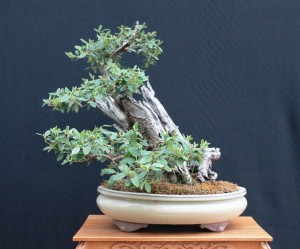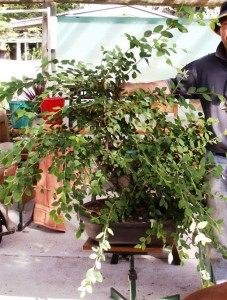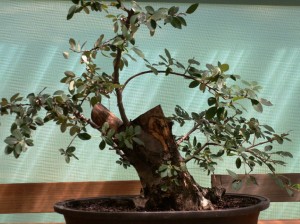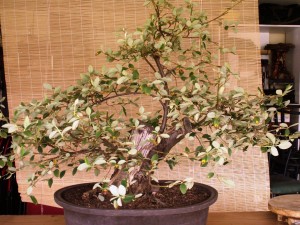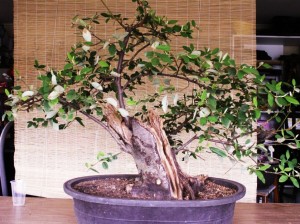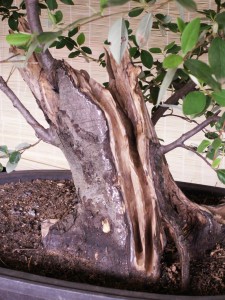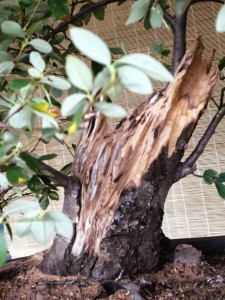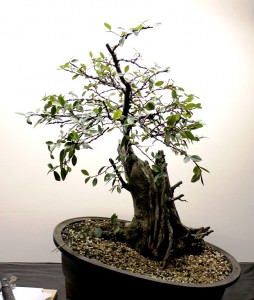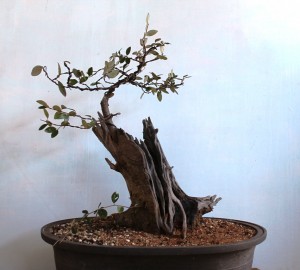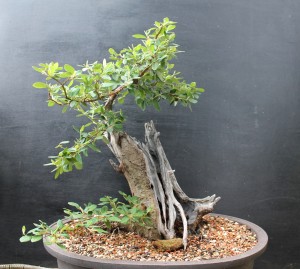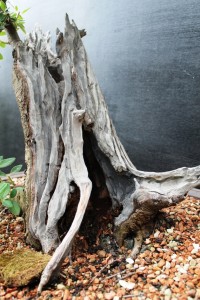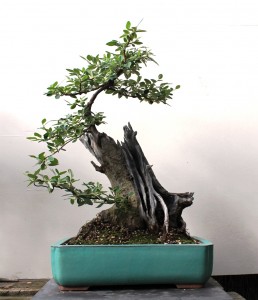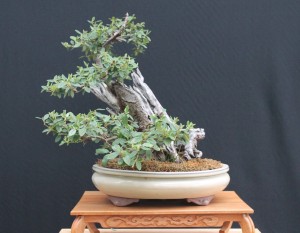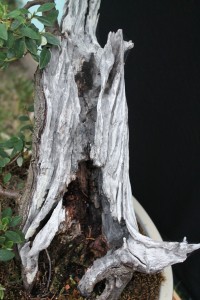This tree, Cotoneaster Glaucophyllus, was widely grown as a garden shrub or small tree in many locations across Australia but is now considered a weed in many areas. Originating in China it has invasive qualities through the distribution of its seeds by birds.
Its personal history is that it was growing in a garden bed at our house and needed to be removed to make way for a new garden design. At the time of removal it was about 4 metres high and about the same wide, with a trunk that was about 24cm wide. It was cut down with a chain saw and then the stump was dug out, placed in an oversize bonsai pot and allowed to recover. This occurred in about 2004 or 2005.
Unfortunately there are no photos of this process, but it did recover and grew quite well. In 2008 I decided it was time to commence this trees journey into bonsai and gave it its first real trim with the aim of developing a few branches for future use.
At its first trim a fair bit of foliage was removed but the basis for a new bonsai remained. It continued to grow well and was continually trimmed with the only other “treatment” given was water and fertilizer. It appeared to be a very strong tree.
In November 2009 I had the opportunity to take this tree to a carving workshop with a number of other bonsai people and Chris De Nola did a little bit of preliminary carving of this, but more importantly to me gave me a few ideas on future carving for the long term benefit for this tree.
I was quite pleased with how this tree was progressing so in May 2010 I had the opportunity to take it along to a workshop conducted by an international bonsai master. The results were not favorable and I took the tree home with the hope that it might survive, but the outlook was grim.
It did come back but many branches that were needed to prevent the dead wood extending into the soil died and as such the tree had a “top heavy” look with most of the foliage on the upper part of the tree. However I was pleased that it did live and went about trying to create a convincing bonsai with what survived.
More than two years had past and still the re-growth was not fantastic, but it was sufficient to let me know that it was surviving and that further work could be done. Some trimming and some wiring and a new look was born. This new look is a little more sparse than I had initially imagined, but it is OK.
The growth of this tree over the next few months was very pleasing with secondary and tertiary branching beginning to show through.
A close-up of the hollow trunk and surrounding carving.
From 2008 until January 2013 this tree had only one re-pot and as the tree was quite healthy I decided a new pot was in order. This pot is a glazed rectangular Chinese pot and will be its new home for the next year or two.
I will need to make a decision on the lower left branch (the first branch) in the near future, but for now it will stay. The lowest branch on the right will need to brought down at the next wiring session. It was wired in mid February, and after only one month the wire needs to be removed to prevent cutting in, so the growth has been good.
In October 2014 I changed the pot to one slightly larger which I thought was an improvement. I continue to refine the carving and encourage healthy growth. It has improved since its near death experience in 2010 and I hope that it will continue to improve over the coming years.

